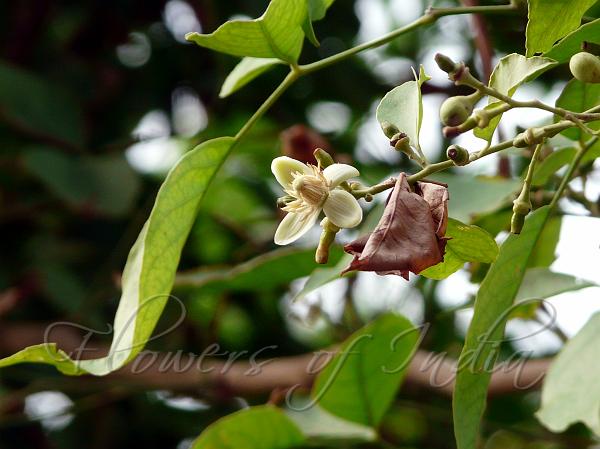|
| Bel |
|

|

| File size | 1562398 |
| Original date | 5/21/08 4:40 PM |
| Resolution | 2048 x 1536 |
| Flash | Flash did not fire, auto |
| Focal length | 46.7mm |
| Exposure time | 1/160s |
| Aperture | 4.0 |
| Focus Distance | |
| Metering Mode | Multi-segment |
| Camera make | Panasonic |
| Camera model | DMC-FZ18 |
| Sensor type | OneChipColorArea |
|
|
|
|
Photo: |
Botanical name: Aegle marmelos Family: Rutaceae (Lemon family)
Synonyms: Crateva marmelos, Aegle marmelos var. mahurensis
Synonyms: Crateva marmelos, Aegle marmelos var. mahurensis
Bel is a fruit-bearing tree which is cultivated throughout India, as well
as in Sri Lanka, northern Malaya, Java and in the Philippines. The tree,
grows up to 15 meters tall
and bears thorns and fragrant flowers. Leaves are alternate, pale green,
trifoliate; terminal leaflet, 5.7 cm long, 2.8 cm broad, having a long
petiole; the two lateral leaflets, almost stalkless, 4.1 cm long, 2.2 cm
wide, ovate to lanceolate, leaf-stallk 3.2
cm long. Flowers are greenish white, sweetly scented, bisexual, stalked;
stalk 8 mm long; diameter of a fully open flower is 3 cm. Flowers are borne
in lateral panicles of about 10 flowers, in leaf axils. The fruit
is woody-skinned, 5-15 cm in diameter. The skin of some
forms of the fruit is so hard it must be cracked open with a hammer. It has
numerous seeds, which are densely covered with fibrous hairs and are
embedded in a thick, gluey, aromatic pulp. The fruit is eaten fresh or
dried. The juice is strained and sweetened to make a drink.
Medicinal uses: All parts of the bael plant consist of immense medicinal properties.
The herbal medicinal preparations of bael are used to treat chronic
diarrhea, dysentery, peptic ulcers, laxative for astringency, and
respiratory ailment.
All parts of the bael plant consist of immense medicinal properties.
The herbal medicinal preparations of bael are used to treat chronic
diarrhea, dysentery, peptic ulcers, laxative for astringency, and
respiratory ailment.
Medicinal uses:
 All parts of the bael plant consist of immense medicinal properties.
The herbal medicinal preparations of bael are used to treat chronic
diarrhea, dysentery, peptic ulcers, laxative for astringency, and
respiratory ailment.
All parts of the bael plant consist of immense medicinal properties.
The herbal medicinal preparations of bael are used to treat chronic
diarrhea, dysentery, peptic ulcers, laxative for astringency, and
respiratory ailment.
| Identification credit: Thingnam Girija | Photographed in Delhi. |
• Is this flower misidentified? If yes,